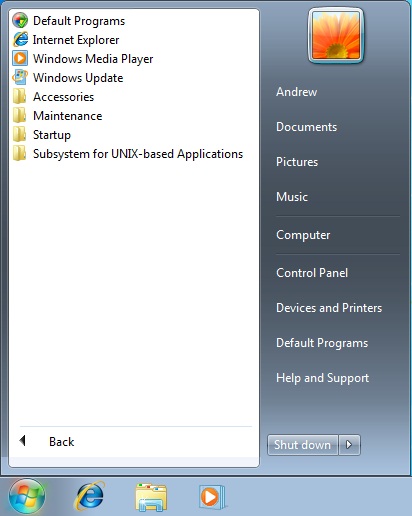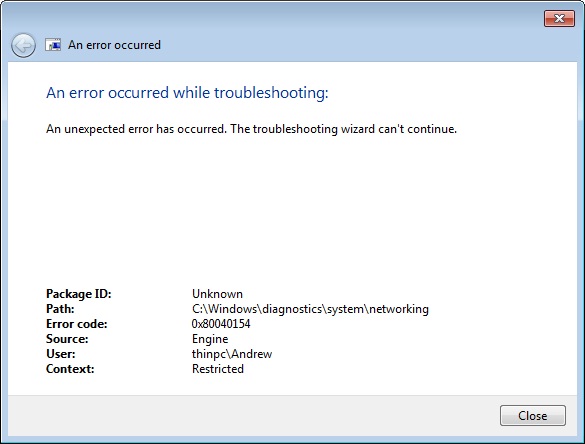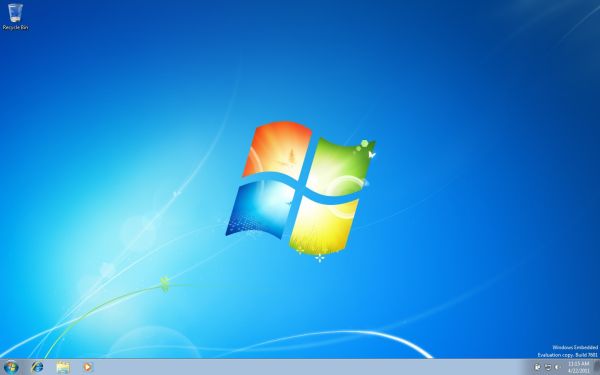Windows Thin PC: Windows, Slimmed Down
by Andrew Cunningham on April 28, 2011 8:00 PM EST- Posted in
- Windows
- Operating Systems
- Microsoft
At First Glance
To test out Windows Thin PC, I used a Dell Inspiron 640m. This rather dated laptop features a 2.0 GHz Core 2 Duo processor, 2GB of RAM, an 80GB hard drive and Intel's GMA 950 integrated graphics chip, the same one that can still be found in many low-end netbooks. It's no screaming rig, but that's not necessary for comparing Windows Thin PC to Windows 7, and I believe the laptop to be more or less representative of the sort of computer on which Windows Thin PC might find a home.
The Windows Thin PC installer is virtually identical to the regular Windows 7 installer, from the first boot screen to the last first-time setup prompt. Installation takes something like half the time that Windows 7 Ultimate does, which makes sense because there are fewer files to copy to the hard drive.
After installation is finished, you’ll be greeted with a very familiar sight:
The “evaluation” text in the corner is the only thing that gives this away as anything but a stock Windows installation, at least until you click the Start button.

Where'd the programs go?
As a thin client-oriented OS, the point of Windows Thin PC is to connect it to a remote server somewhere – in theory, you’re not supposed to be doing a lot of actual computing on the machine in front of you, but rather on a Remote Desktop Services (formerly Windows Terminal Services) server somewhere via Microsoft’s Remote Desktop Protocol (RDP).
This is backed up by the dearth of installed applications – you still have Internet Explorer, Windows Media Player, the Remote Desktop client, the Windows accessibility tools, system-level stuff like the Administrative Tools (Event Viewer, Computer Management, etc.) the disk defragmenter, and old Windows 3.x standbys like Paint, Notepad, and Wordpad (though the latter three, among others, don’t appear on the Start menu by default). The bigger value-added Windows programs, though, like DVD Maker and Media Center, are completely absent, as are certain underlying technologies like the .NET Framework.
This is all done in the name of saving space, both on the disk and in memory - sitting idle at the Windows desktop with all Aero effects enabled (Aero Basic is enabled by default to save resources) Windows Thin PC used 505 MB of RAM, where Windows Ultimate installed on the same computer uses about 621 MB. This is a decent improvement, but the disk space usage comparison is much more impressive: a fresh install of Windows Ultimate uses 8.64 GB of my hard drive, where Windows Thin PC on the same computer uses just 2.7 GB of space.
This is a pretty drastic reduction in space, one that can't be achieved just by removing Media Center and other integrated programs - I dig down deeper to see where Microsoft was gaining all of these gigabytes.
Digging Deeper
The single biggest chunk of the saved space, some 3.5 GB of the 6 GB difference, is gained by disabling virtual memory and hibernation, tricks you can use on any Windows PC anywhere. By default, Windows will reserve a virtual memory pagefile (pagefile.sys) on your hard disk that equals the size of your installed RAM - on my test machine, this was 2GB, but it will dynamically shrink or grow based on your system. The hibernation file, where Windows stores the contents of RAM when it drops into its lowest power state, also changes its size based on your machine's installed RAM, though it wasn't quite a 1:1 ratio on my test machine (hiberfil.sys consumed 1.5 GB of space on my test machine).
The rest of the space is all gained by the removal of programs and system files. Several services normally included in Windows 7 - System Restore, Windows Search, and Windows Defender among them - are not just disabled but completely removed from Windows Thin PC, and with the binaries for these programs go their various hidden system folders they scatter throughout your hard drive.
Reduction in the number of background services running also saves you what little RAM that ThinPC saves over Windows 7. In addition to missing Windows Search and Windows Defender, Superfetch (the Windows Vista and Windows 7 feature that preemptively loads heavily used programs into memory to reduce load time) and the Diagnostic Service Host (the service behind all of those Windows troubleshooters) are disabled too. Trying to run a normal troubleshooter in ThinPC will throw up an error message, instead.

Back to disk space usage - Windows Thin PC also pares down your fonts folder pretty significantly - Thin PC includes just 41 fonts to Ultimate's 134, and this by itself saves around 500 MB of hard drive space. If a web page or Word document depends on a standard Windows font that isn't included in Thin PC, this can sometimes prevent these pages and documents from rendering properly.
Generally speaking, a side-by-side comparison of Windows Thin PC and Windows 7 shows that many system folders have been cut, usually by one or two-thirds - for example, the System32 folder (including subfolders) is 1.43 GB in Thin PC, but 1.92 GB in Windows 7.
So, obviously and by design, Windows Thin PC is missing quite a bit compared to a standard Windows 7 install. However, I was curious to see how Thin PC reacted to the installation of third-party programs - licensing issues aside, could Windows Thin PC serve as a very light version of Windows 7, instead of just a thin client OS?











46 Comments
View All Comments
Bob-o - Friday, April 29, 2011 - link
Agreed. I know it wasn't really the focus of the article, but. . . what a pathetic thin client platform. Microsoft, go get some tips from Oracle's Sun Ray.Spivonious - Friday, April 29, 2011 - link
Agreed. This seems more like "Windows Lite" than a true thin client OS. We have Wyse thin clients at work and all they do is boot and then connect to a hosted virtual machine.Samus - Wednesday, February 22, 2012 - link
I don't mean to dig up an old thread, but I wanted to comment on this product AFTER RTM, which was July 2011, 3 months after this article was posted.I've installed OSX 10.5.8, 10.6.3, and a variety of Linux distro's on my HP Mini. I decided to give Win7ThinPC a shot. Since the Mini has a pathetic Sandisk uSSD with a 40MB/sec ATA4 (PATA) interface, it is just slightly faster than a Class 10 SDHC card.
I've run Windows 7 Ultimate 32-bit, which took up ~10GB of the SSD, and it was slow, but usable. Thin PC is faster. Boot times, logon times, suspend/resume, and overall snappyness are improved.
We're talking an Atom N270 1.6GHz dualcore CPU, which is patheticly slow, around the speed of a Pentium III 800MHz, so web browsing performance is not great, especially with flash content, so Thin PC doesn't help this, but it does reduce SSD access, which is good, because the SSD is slow.
What I'm getting at, is if you want to run Windows 7 from a MEMORY CARD, this is your best option.
I successfully embeeded and registered .NET 2.0 and 3.5 into Win7 Thin PC as well in order to run SyncToy and Paint.NET
Current volume licensing from Provantage and CDW puts this OS at $15/year/PC. Pretty good value if you plan on upgrading in a few years, anyway.
iwod - Friday, April 29, 2011 - link
I am running Windows 7 on my LaptopPentium M, Dothan 1.8Ghz ( That is Single Core )
1GB DDR Ram
ATI X600 Gfx
For 70% of my work load this machine does fine. And i haven't tweaked anything yet. I suspect if it had a super fast SSD plus 4GB memory it would be just as fast as best in class PC in 90% of office situation.
formulav8 - Saturday, April 30, 2011 - link
I actually installed Windows 7 - RC1 on a Pentium 3 - 1.13ghz laptop and 512 MB of sdram. Was VERY impressed with how well the response and performance was. Did basic things perfectly fine.I've started putting Win 7 Premium on some of the laptops I sell to customers (Mainly Pentium M Banias/Dothan based) and they are working just fine. Some of them can even do Aero (Like the NC6000's which use a Radeon 9600) if I remember corrently. So I am quite impressed overall with Windows 7.
Jason
SteelCity1981 - Friday, April 29, 2011 - link
Seems like MS is copying RT by doing this. I mean you could make your own stripped down copy of Windows 7 with Se7en Lite.damianrobertjones - Friday, April 29, 2011 - link
No, they're not. Windows XP was also available in the samd format.Mugur - Friday, April 29, 2011 - link
I can find something usable here. One of my clients is preparing to throw Windows 7 Enterprise/Office 2010 to their old office PCs (1 core Celerons, 1-2 GB RAM, 40-80 GB hdd). They also have POSes currently on XP Pro with the same hardware...Also I would like to see this on the netbook crowd, instead of that ugly Starter Edition... But I'm afraid that the price is much higher.
Some of my coleagues encountered the current or previous Windows Embedded versions and there were quite a few quirks setting it up as a POS... This is probably just the next iteration of it, with a bit of a "cloud/thin PC" marketing flavor. But it has a logic for an App-V/MDV client...
lwatcdr - Friday, April 29, 2011 - link
Windows 7 is actually pretty good at running on old hardware. My wife uses it on her many year old AMD Turon64 powered notebook. I do not remember how old it is but it uses PATA for the hard drive it that tells you anything. If anything you may need more drive space or better yet setup a NAS With roaming profiles. I have even run Windows 7 basic under virtualbox on my macbook with the memory in Virualbox set down to 512m with no problems. It will probably run just fine depending on the clock speed. If they are at least 1Ghz I wouldn't sweat it.Of course the idea of a 1+ghz gigabyte of ram system being used for a POS system is really just getting into the level of the surreal.
haplo602 - Friday, April 29, 2011 - link
So basicaly the system is not different from a lightly tuned Win7 ? Ok the missing fonts are maybe the largest problem, but one can still install them later right ?I thought it would be a bare windows with terminal services and minimal desktop features. So far for MS effort to generate new revenue from the same box with different label.